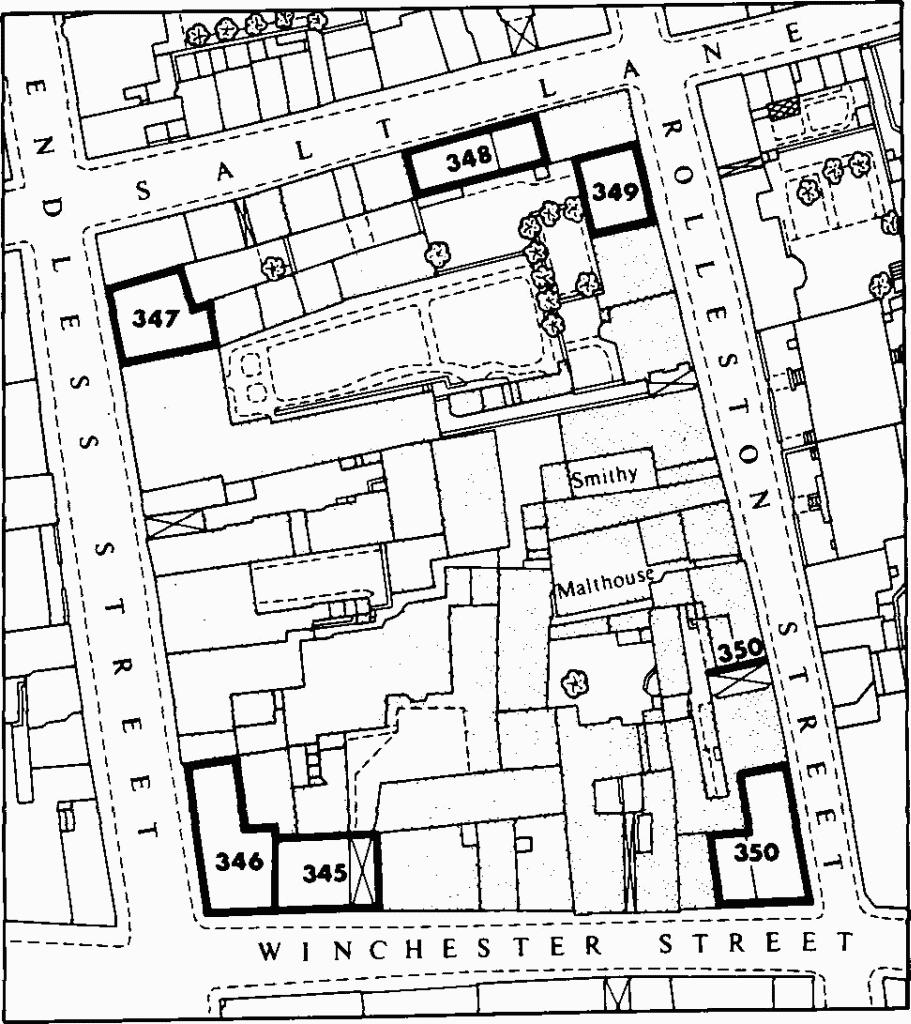Ancient and Historical Monuments in the City of Salisbury. Originally published by Her Majesty's Stationery Office, London, 1977.
This free content was digitised by double rekeying. All rights reserved.
'Three Swans Chequer', in Ancient and Historical Monuments in the City of Salisbury(London, 1977), British History Online https://prod.british-history.ac.uk/rchme/salisbury/pp134-135 [accessed 27 April 2025].
'Three Swans Chequer', in Ancient and Historical Monuments in the City of Salisbury(London, 1977), British History Online, accessed April 27, 2025, https://prod.british-history.ac.uk/rchme/salisbury/pp134-135.
"Three Swans Chequer". Ancient and Historical Monuments in the City of Salisbury. (London, 1977), British History Online. Web. 27 April 2025. https://prod.british-history.ac.uk/rchme/salisbury/pp134-135.
Three Swans Chequer
(345) Warehouse, No. 5 Winchester Street, formerly part of the Three Swans Hotel, (fn. 1) is of three storeys with brick walls and tiled roofs and was built probably c. 1770. (fn. 2) The five-bay S. front has, on the E., the opening to a carriage through-way; above it are Palladian windows in both upper storeys; elsewhere there are plain sashed windows. Above are a heavy brick cornice and a shaped pediment. Inside, some 18th-century chimneypieces remain.

Monuments in Three Swans Chequer.
(346) House, No. 2 Endless Street, now a shop and warehouse, is three-storeyed with brick walls and tiled roofs and appears to be mainly of the first half of the 18th century; a two-storeyed wing on the N. is of 17th-century origin. Above modern shop windows the fourbay S. front, flanked by large pilasters, has two storeys of plain sashed windows. Inside, some rooms have moulded cornices and panelled dados. The S. wall of the N. wing is of 17th-century timber framework.
(347) House, No. 12 Endless Street, now two-storeyed but formerly of three storeys, has brick walls and tiled roofs; it is of mid 18th-century origin, but has been much altered. The five-bay W. front was originally symmetrical, with a central doorway with a wooden pediment and with sashed windows with keystones. Several of the windows have been blocked and two have been raised and enlarged to correspond with altered floor-levels. Inside, some original panelled dados remain.
(348) Warehouses, two, standing end-to-end on the S. side of Salt Lane, are two-storeyed with brick walls and tiled roofs. Some internal timber framework, with jowl-headed posts supporting collared tie-beam trusses, suggests that the buildings are of 16th-century origin. Late in the 18th century the exterior was rebuilt in brickwork, with plain segmental-headed openings. (Demolished, 1978.)
(349) House, of two storeys with brick walls and a tiled roof, dates from the second half of the 18th century. In the E. front the upper storey retains six uniform sashed windows; below, the openings have been altered and the position of the original doorway is unknown. The interior has been entirely modernised.
(350) Old George Inn, at the S.E. corner of the chequer, is two-storeyed with attics and has rendered brick walls and tiled roofs. Some beams and roof-trusses appear to be of c. 1500; the facades were rebuilt about the middle of the 17th century and the windows were remodelled c. 1800 (Plate 79). The central doorway in the approximately symmetrical S. front has fluted wooden columns supporting a flat hood with foliate enrichment. Some ground-floor windows have keystones with human masks. The E. gable of the S. range has two blocked 17th-century oval windows with hollow-chamfered stone surrounds. Inside, the first-floor rooms in the W. range have chamfered ceiling beams with shaped stops. The oak stairs from the first floor to the attic are of the 17th century, with heavy turned balusters, close strings and plain newel posts (Plate 87); lower, the staircase is of c. 1800. The roofs have collared tie-beam trusses supporting chamfered purlins.